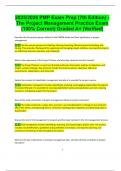2025/2026 PMP Exam Prep (7th Edition) -
The Project Management Practice Exam
(100% Correct) Graded A+ |Verified|
Describe the five process groups defined in the PMBOK Guide and their significance in project
management.
The five process groups are Initiating, Planning, Executing, Monitoring and Controlling, and
Closing. They provide a framework for organizing and managing project activities, ensuring that projects
are effectively planned, executed, and completed.
What is the importance of the Project Charter, and what key elements should it include?
The Project Charter is crucial as it formally authorizes the project, outlines its objectives, and
assigns a project manager. Key elements include the project purpose, objectives, high-level
requirements, stakeholders, and initial risks.
Explain the concept of stakeholder management and why it is essential for project success.
Stakeholder management involves identifying, analyzing, and engaging stakeholders throughout
the project lifecycle. It is essential for ensuring stakeholder needs and expectations are met, reducing
resistance, and gaining support for the project.
How do the triple constraints of project management influence project outcomes?
The triple constraints—scope, time, and cost—are interdependent. A change in one constraint
affects the others, and balancing them is critical for meeting project objectives and delivering value to
stakeholders.
Discuss the role of risk management in projects and the steps involved in the risk management process.
Risk management involves identifying, assessing, and responding to project risks. The process
includes risk identification, qualitative and quantitative risk analysis, risk response planning, and
continuous monitoring of risks throughout the project.
What are the key components of a project management plan, and how do they contribute to project
execution?
1
, A project management plan includes scope, schedule, cost, quality, resource, communication,
risk, procurement, and stakeholder management plans. These components guide project execution,
ensuring alignment with project objectives.
Explain the difference between qualitative and quantitative risk analysis and their respective
methodologies.
Qualitative risk analysis assesses risks based on their probability and impact using tools like risk
matrices, while quantitative risk analysis uses numerical techniques such as Monte Carlo simulations to
evaluate the effect of risks on project objectives.
What is the significance of a Work Breakdown Structure (WBS) in project planning?
A WBS breaks down the project into smaller, manageable components, facilitating better scope
definition, resource allocation, and scheduling, ultimately improving project control and monitoring.
Describe the process of developing a project schedule and the tools commonly used.
Developing a project schedule involves defining activities, sequencing them, estimating durations,
and determining resource requirements. Tools like Gantt charts, critical path method (CPM), and PERT
charts are commonly used for visualization and tracking.
How does the concept of earned value management (EVM) provide insights into project performance?
EVM integrates scope, schedule, and cost to assess project performance through metrics like
Planned Value (PV), Earned Value (EV), and Actual Cost (AC). It helps identify variances and forecast
project completion.
Explain the role of communication management in project success and key components of a
communication plan.
Communication management ensures timely and effective information dissemination among
stakeholders. Key components of a communication plan include stakeholder analysis, communication
methods, frequency, and responsibility assignments.
What are the different types of project life cycles, and how do they affect project management
practices?
2




